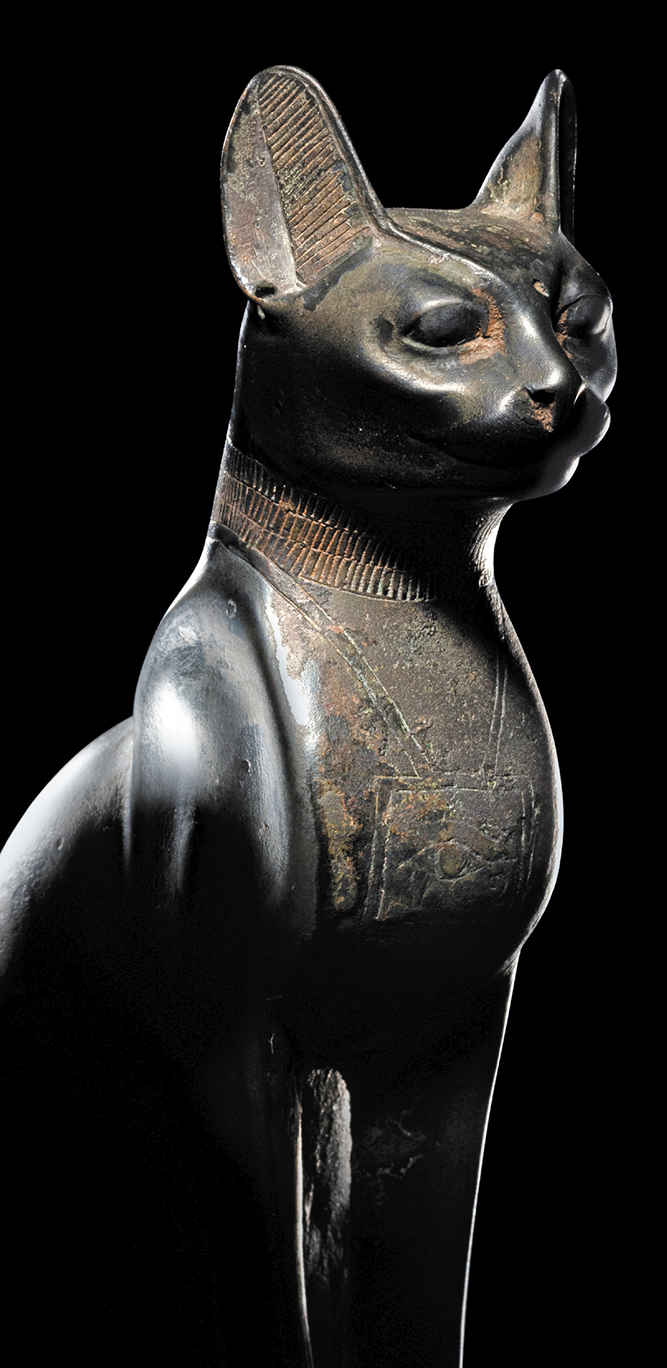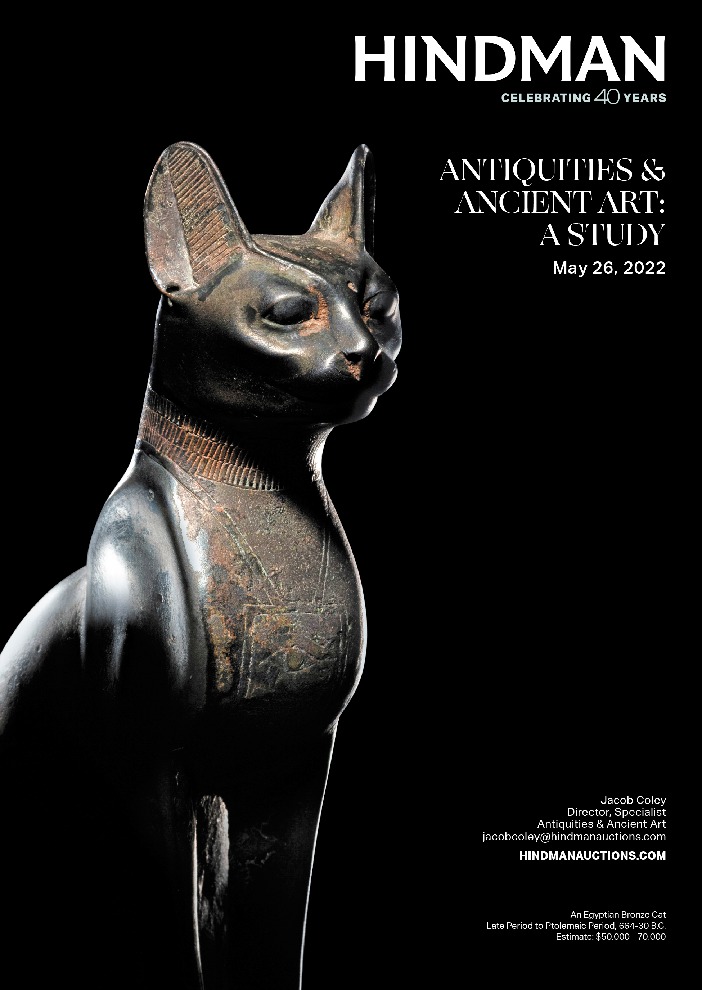Events
Home / Events

Hindman Antiquities & Ancient Art: A Study
Thu May 26, 2022 - Thu May 26, 2022
-
Hindman Antiquities & Ancient Art: A Study
May 26, 2022
Hindmanauctions.com
jacobcoley@hindmanauctions.com
CHICAGO — In its May 26 antiquities and ancient art auction, Hindman examines what it means to be an antiquarian in every sense of the word. With more than 200 lots, the sale highlights the civilizations that formed the foundation of our modern world, offering objects for novice and experienced collectors alike. From an Egyptian female figure made of the civilization’s most cherished magical material, faience, to a Roman portrait head of Antisthenes, who laid the foundation of Cynic philosophy, to a Roman marble Capitoline-type statue of Venus, the goddess of Love, the oldest god according to Plato’s Symposium, this sale explores just what it means to be a scholar and aficionado of the ancient world.
The top lot of the auction is expected to be a Roman marble statue of the goddess Venus ($200/300,000). During the Fourth Century BCE, the ancient Greek sculptor Praxiteles created a legendary statue of the goddess of love in modest pose known today as the Aphrodite of Knidos (or Cnidus). It was one of the first life-sized representations of the nude female form in Greek history. Prior to its creation, Greek sculpture had been dominated by nude figures of heroic men. Even in antiquity, the sculpture was considered a masterpiece with famed Roman historian Pliny the Elder saying it was “superior to all statues.” To the Greeks, she was Aphrodite; to the Romans, she was Venus. To all, she is the goddess of Love, whose iconic image remains compelling to this day.
Though the original Greek sculpture is no longer in existence, a myriad of nude Aphrodite were created during the Hellenistic and Roman period, which the wealthy Romans of the imperial period acquired to decorate their villas and gardens. Among these versions, two principal types repeat her modest pose: the Capitoline Venus and the Medici Venus, which differ from each other in their formal details. The statue offered in this auction belongs to this series, and even combines traits of one (the hairstyle and the position of the feet of the Capitoline Venus) with the other (the elongated proportions and the presence of the dolphin on the Medici statue).
The auction begins with 49 lots from one of humanity’s earliest and most influential civilizations: the ancient Egyptians. Among these lots is a female figure molded and glazed in blue faience ($70/90,000), a substance that the Egyptians believed bestowed a magical property to the objects crafted in it. This figure is identified as a Khener-dancer meant to convey sexuality and vitality and was likely a part of a larger set originally. This particular piece is considered one of the best-known examples in private hands and was exhibited at the Cincinnati Art Museum and Brooklyn Museum of Art in the 1990s.
Other Egyptian highlights include an Egyptian bronze cat ($50/70,000); an Egyptian gilt cartonnage mummy mask ($50/60,000); and an alabaster head of a jackal ($30/50,000).
The auction continues with objects from ancient Near East civilizations that were so foundational to modern society that the region is commonly known as the Cradle of Civilization. The section includes weaponry, pottery, writing tablets, stone figure and more. Among the highlights is a Neo-Assyrian carved hematite head of the demon Pazuzu ($10/15,000). Pazuzu was renowned for protecting humans from plague and evil forces. This particular example, like many Pazuzu heads, was discovered with drilled holes or loops, suggesting it was worn around the neck. It is thought that pregnant women would wear these heads to protect their unborn babies from evil forces.
A constant across the countless civilizations that have risen and fallen in human history is the presence of jewelry. Whether that be a simple stone-carved medallion or an intricate golden crown, humans have always felt the need to adorn themselves with items that accentuate their beauty, wealth and status. This auction features 32 lots of jewelry including a Western Asiatic gold bracelet with lion-headed terminals from the Eighth-Sixth Century BCE ($10/15,000).
Closing out the auction are more than 100 lots of pottery, statues, sculptures, bronzes, glassware and more from ancient Greco-Roman cultures. Headlined by the Roman Venus statue, marble pieces are expected to be in high demand during the auction, including a Roman portrait head of the Greek philosopher Antisthenes ($100/150,000). Other marble highlights include a Cycladic reclining female figure ($30/50,000); a Greek head of a lion ($30/50,000); and a Roman portrait head of a man ($30/40,000).
Hindman is at 1338 West Lake Street. For more information, www.hindmanauctions.com or 312-447-3271.
An Egyptian Bronze Cat Late Period to Ptolemaic Period, 664-30 B.C. Estimate: $50,000 – 70,000
Jacob Coley Director, Specialist Antiquities & Ancient Art jacobcoley@hindmanauctions.com

Antiques and The Arts Weekly is the nation’s leading weekly publication on the antiques and the arts trade, and is available both in print and online.
Each issue average between 100-200 pages and includes reporting on auctions, antiques shows and the arts while providing a platform for both buying and selling.
We have been providing breaking news and important information on the world of antiques and the arts since Publisher R. Scudder Smith started Antiques and The Arts Weekly back in 1963.
Contact
LOCATED AT:
5 Church Hill Road / Newtown, CT 06470
HOURS:
Mon - Fri / 8:00 am - 5:01 pm
PHONE:
(203) 426-8036

